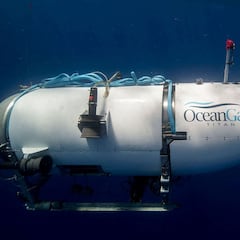The use that the CEO of OceanGate wanted to give to the Titan submersible: “The greatest resource is oil and gas”
Stockton Rush, CEO of OceanGate, who was piloting the tragic voyage of the Titan, had more in mind for the submersible than just tourism to the Titanic.

Unfortunately, the desire to explore and discover can lead to tragic situations. One of these occurred when the submersible Titan, in its attempt to visit the wreckage of the Titanic, suffered a catastrophic implosion that caused the deaths of five people.
All of this prompted the research and exploration company OceanGate, owner of the Titan submersible, to put an end to its expeditions and commercial operations. In other words, it will not make any more trips to the ocean liner nor to other destinations, as it advertised on its website until five days ago.
Deep sea mineral extraction
About a month after this fateful episode, the investigation continues to determine what could have gone wrong for the OceanGate submersible to implode in the waters of the North Atlantic. However, new details have also come to light, revealing that the CEO of OceanGate, Stockton Rush -who died in the accident-, intended to use the Titan for the extraction of minerals in deep water at the bottom of the sea.
Speaking to the business magazine Fast Company six years ago, Rush discussed plans to use the untested vehicle to harvest mineral resources from the depths of the ocean to bring them to the surface, with the hope of reducing the cost of traveling to the bottom of the ocean in the future.
Controversial deep sea mining is killing ocean life, warns study https://t.co/iVRJd7kvxj
— BBC Science Focus Magazine (@sciencefocus) July 14, 2023
The Titan as an example for the future
In other words, its first customers would pay more to be among the first tourists to visit the depths of the ocean. This would mean that the amount he could charge for a seat, $250,000 for Titan’s last voyage, would decrease as he takes more people underwater among the Titanic’s wreckage.
“The biggest resource is oil and gas, and they spend about $16 billion a year on robots to service oil and gas platforms,” the entrepreneur said. He added that the success of the tourist dives could show people that his submersible could be used in deep-sea mining operations.
“The Titanic is where we go from startup to ongoing business”
Now, the main disadvantage is that the oil and gas companies do not accept new technology and want it to be tested. The long-term value is in the commercial side. Adventure tourism is a way to monetize the process of proving the technology,” pointed out the general director of OceanGate.
As if this were not enough, he declared that “the Titanic is where we go from startup to ongoing business”. Unfortunately, Rush will never see his vision come to fruition as the Titan’s carbon fiber hull succumbed to the pressure exerted by the depths where the ship still resides.
In a paper published on May 25, 2023, researchers found that there are likely 5,000+ new-to-science species in the Clarion-Clipperton Zone (CCZ), an area in the Pacific Ocean that’s being eyed for deep-sea mining. The region spans more than 1.7 million square miles and is rich in… pic.twitter.com/xq097ebkNQ
— NowThis (@nowthisnews) July 13, 2023
What is deep sea mining?
Related stories
It should be noted that deep sea mining involves extracting resources from the seabed, including mineral deposits and rare earth minerals and metals such as nickel, copper and lithium. Proponents of deep-sea mining say it can help address demand for materials needed for electric vehicles, the transition to clean energy, and everyday items like smartphones and laptops.
At the other extreme, critics worry that deep-sea mining could have devastating effects on the oceans and marine life, including ecosystems that are still being affected. They don’t know many things. That is why marine scientists say that not enough investigations have been carried out in the deep sea to fully assess the possible implications of mining operations.

